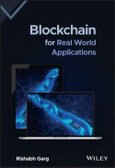A comprehensive examination of blockchain architecture and its key characteristics
Blockchain architecture is a way of recording data such that it cannot be altered or falsified. Data is recorded in a kind of digital ledger called a blockchain, copies of which are distributed and stored across a network of participating computer systems. With the advent of cryptocurrencies and NFTs, which are entirely predicated on blockchain technology, and the integration of blockchain architecture into online and high-security networked spaces more broadly, there has never been a greater need for software, network, and financial professionals to be familiar with this technology.
Blockchain for Real World Applications provides a practical discussion of this subject and the key characteristics of blockchain architecture. It describes how blockchain technology gains its essential irreversibility and persistency and discusses how this technology can be applied to the information and security needs of different kinds of businesses. It offers a comprehensive overview of the ever-growing blockchain ecosystem and its burgeoning role in a connected world.
Blockchain for Real World Applications readers will also find: - Treatment of real-world applications such as ID management, encryption, network security, and more - Discussion of the UID (Unique Identifier) and its benefits and drawbacks - Detailed analysis of privacy issues such as unauthorized access and their possible blockchain-based solutions
Blockchain for Real World Applications is a must for professionals in high-security industries, as well as for researchers in blockchain technologies and related areas.
Table of Contents
Illustrations xix
Foreword xxv
Preface xxvii
1 Introduction 1
2 Distributed Ledger Technology 11
2.1 Different Types of Distributed Ledger Technology 11
2.2 Chronological Evolution 13
2.3 Blockchain Architecture 15
3 Blockchain Ecosystem 23
3.1 Working of Blockchain 24
3.2 Key Characteristics 29
3.3 Unspent Transaction Output 30
3.4 Classification of Blockchain on Access Management 30
3.5 Consensus 32
3.6 Payment Verification in Blockchain 37
3.7 Hashgraph 39
3.8 Scalability 40
4 Transactions in Bitcoin Blockchain 43
4.1 Coinbase Transactions 43
4.2 Transactions Involving Fiat Currency 47
4.3 Top Fiat Currencies for Bitcoin Transactions 50
4.4 Price Determination for Bitcoin in Transactions 51
4.5 Controlling Transaction Costs in Bitcoin 57
5 Ethereum and Hyperledger Fabric 67
5.1 Early Attempts to Program Cryptocurrencies 68
5.2 Smart Contracts 69
5.3 Working of Ethereum 72
5.4 Hyperledger 74
5.5 Working of Hyperledger 74
5.6 Ethereum Versus Hyperledger 79
5.7 Decentralized Applications 81
5.8 Tokens 84
6 Identity as a Panacea for the Real World 87
6.1 Identity Systems 87
6.2 Centralized Model 92
6.3 Cost and Benefits 100
6.4 Quest for One World - One Identity 108
7 Decentralized Identities 115
7.1 Identity Models 115
7.2 Block chain-based Solutions 117
7.3 Identity Management 119
7.4 Identity Storage | Interplanetary File System 121
7.5 Biometric Solutions 130
7.6 Identity Access 139
7.7 Merits of a Proposed System 141
7.8 Disadvantages of the Proposed System 144
7.9 Challenges 145
7.10 Solutions with Hyperledger Fabric 146
8 Encryption and Cybersecurity 151
8.1 Cryptography 151
8.2 Playfair Cipher 153
8.3 Hill Cipher 167
8.4 RSA Algorithm in Cryptography 171
8.5 Multiple Precision Arithmetic Library 175
8.6 SHA-512 Hash in Java 180
8.7 Cybersecurity 183
9 Data Management 193
9.1 Data Science 193
9.2 Education and Employment Verification 194
9.3 Health Care 204
9.4 Genomics 210
9.5 Food Supply Chain 211
9.6 Real Estate 213
9.7 Crowd Operations 216
10 Banking and Finance 227
10.1 Banking and Investment 227
10.2 Trade Finance 236
10.3 Auction Process 248
10.4 Decentralized Finance 263
10.5 Prediction Markets 286
11 Growing Landscape of Blockchain 297
11.1 Blockchain Applications in Real World: An Overview 297
11.2 e-Governance 297
11.3 Supply Chain Management 305
11.4 e-Commerce 310
11.5 Distributed Resources and Internet of Things 317
11.6 Decentralized Streaming 320
12 Functional Mechanism 329
12.1 Software Requirements 329
12.2 Installing a Mobile Application 330
12.3 Fetching or Uploading the Documents 331
12.4 Government or Third-party Access 335
12.5 Credibility Through Smart Contracts 336
12.6 User-Optimized Features 337
Appendices 339
Glossary 347
Index 371








